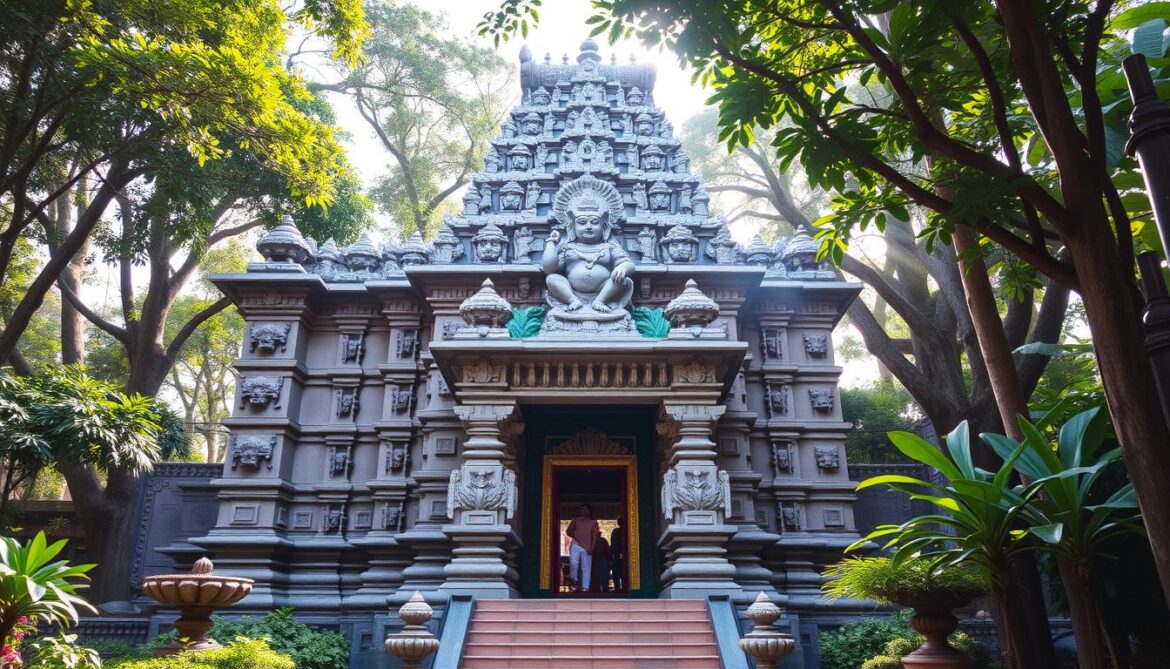Lord Narasimha, also known as Narasimha Deva, is a key figure in Hindu mythology. Many temples are built in his honor.
Simhachalam is one of the 32 Narasimha temples in Andhra Pradesh. It’s 300 meters above sea level. It’s the second-largest temple in the state by income.
The temple’s history goes back to the 11th century CE. It was consecrated in 1268 CE by King Bhanudeva I. This shows Lord Narasimha’s lasting impact.
The temple celebrates many festivals, like Kalyanotsava and Chandanotsava. These festivals show Narasimha Deva’s importance in Hindu mythology.
Overview of Lord Narasimha
Lord Narasimha is a key figure in Hinduism. He is seen as a protector and savior. He looks like a half-man, half-lion, showing his special powers.
The Narasimha Jayanti festival is very important. It celebrates Lord Narasimha’s birth. People come together to honor him with rituals and ceremonies.
Historical Significance of Narasimha Temples

Narasimha temples have a long history. They are mentioned in ancient texts like the Narasimha Ashtakam and Narasimha Kavacham. These texts show Narasimha’s big role in Hindu stories and his fight to keep dharma.
Ancient Texts and References
The Puranas talk about Lord Narasimha. They show how important he is in Hindu myths. The Narasimha Ashtakam and Narasimha Kavacham are key texts that highlight Narasimha’s importance.
Evolution of Worship Practices
Worship in Narasimha temples has changed over time. This change came from texts like the Narasimha Ashtakam and Narasimha Kavacham. These texts have helped shape the spiritual practices and traditions of Narasimha temples.
Popular Temples in India
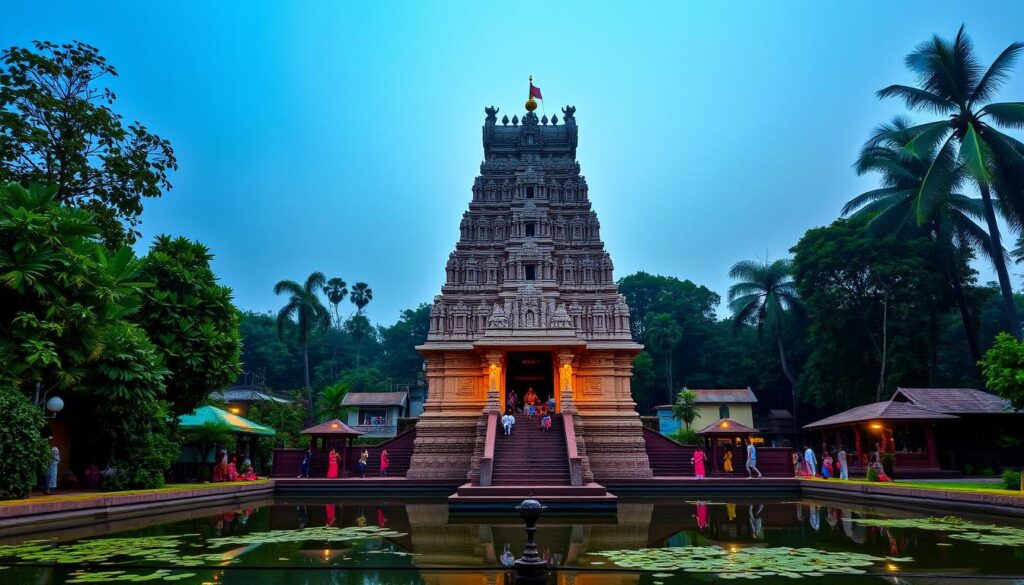
India has many temples for Lord Narasimha, each special in its own way. The Narasimha Stotram is key in these temples, showing the deep faith of the people. The Lakshmi Narasimha Temple in Ahobilam, Andhra Pradesh, is famous. It’s one of nine temples in the area.
The Kallazhagar Temple in Madurai is known for its beautiful design and lively festivals. The Narsimha Swamy Temple in Tadpatri is also a big pilgrimage spot. These Narasimha Temple sites are sacred and hold a lot of cultural and historical value.
People visiting these temples can see the beauty of Indian architecture and the spiritual practices. This includes the Narasimha Stotram. These temples show the lasting impact of Lord Narasimha in India.
Unique Architectural Features
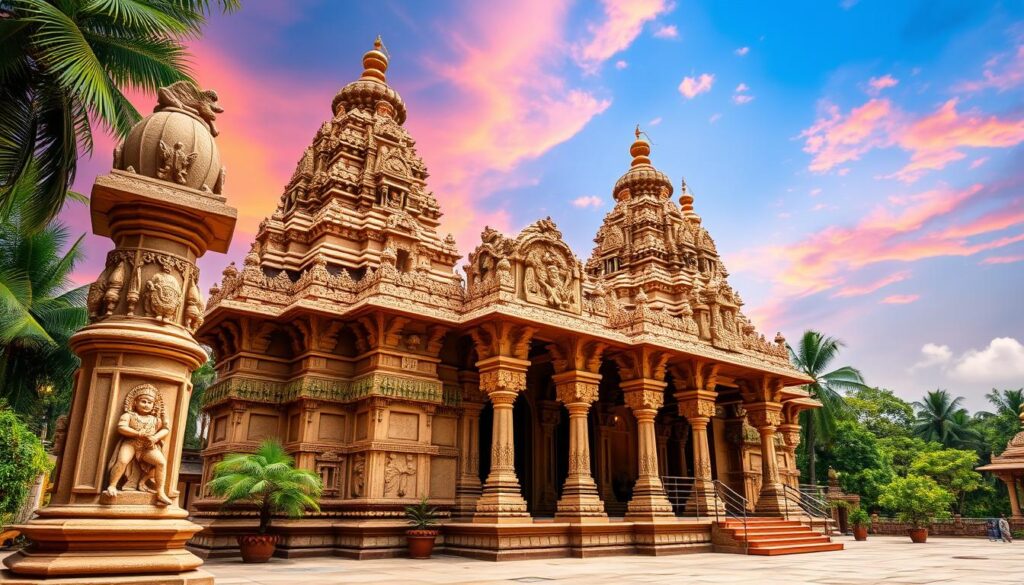
The temples for Lord Narasimha show off different architectural styles. These styles reflect the culture and history of their time. The Dravidian and Nagara styles are two main ones, each with its own look.
These temples have detailed carvings, sculptures, and fancy decorations. This shows the skill of the craftsmen who made them. The choice of materials like stone and wood also makes them look great.
Dravidian vs. Nagara Styles
The Dravidian style uses granite and sandstone. It has detailed carvings and sculptures of Hindu gods and myths. On the other hand, the Nagara style is more ornate. It focuses on brick and stone.
Common Elements in Narasimha Temples
Even though they look different, Narasimha temples share some things. They often have vimanas (towers) and mandapas (pillared halls). These show the shared culture and faith of the temples.
- Intricate carvings and sculptures
- Ornate decorations and patterns
- Use of specific materials, such as stone and wood
These features make Narasimha temples special. They show the artistic and cultural heritage of the area.
Festivals Celebrated in Narasimha Temples
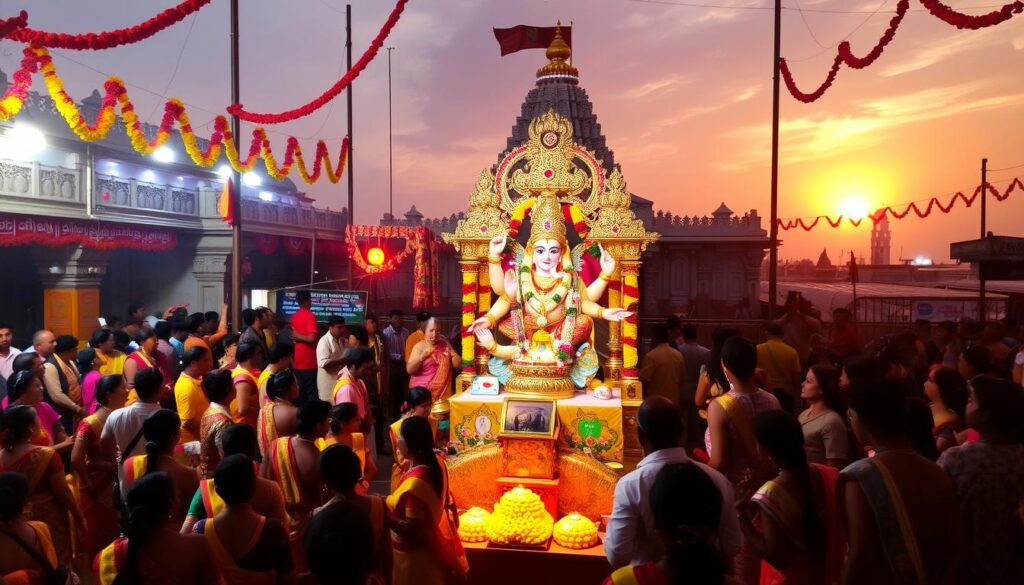
Narasimha temples are filled with life during festivals. The biggest one is Narasimha Jayanti. It happens on the 14th day of Vaisakha. This day honors Lord Narasimha, known for his bravery and protection.
On Narasimha Jayanti, people do many things. They do puja, fast, and give to charity. The Narasimha Mantra is key, believed to help spiritually. Some temples have feasts, while others have dances like the bhagavata mela.
- Early morning dips in sacred rivers
- Offerings of sandalwood powder, saffron, and fruits
- Fasting from sunrise to sunset
- Evening prayers and Aarti
These festivals and rituals are a big part of Narasimha temple life. They help people grow spiritually and bond with each other.
Sthalapurana: The Legends Behind the Temples
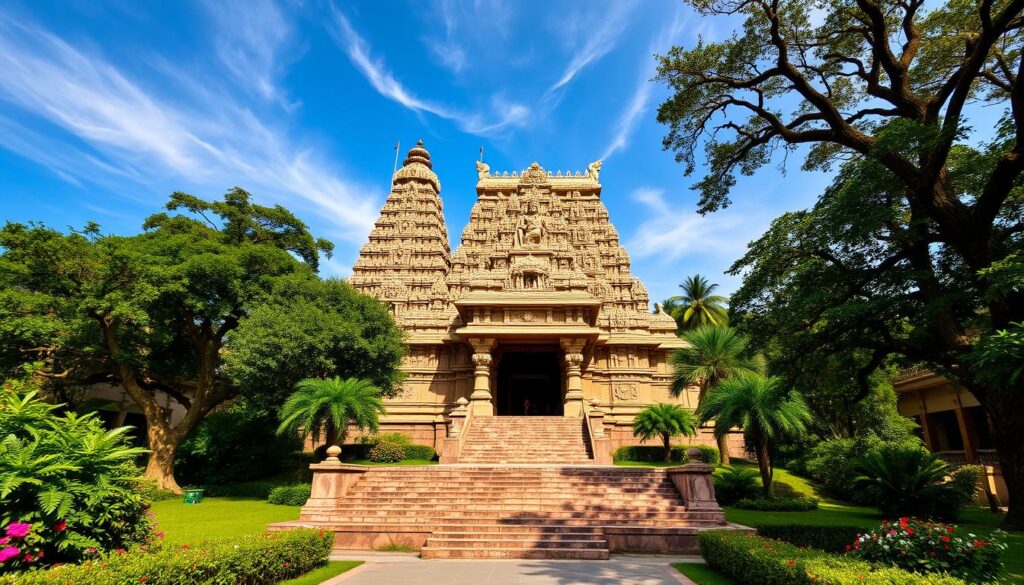
The Sthalapurana of Ahobilam talks about nine forms of Narasimha. It shows why this place is key in Narasimha Swamy worship. The text has ten chapters, each covering different parts of the sacred area and the Narasimha Temple’s role.
Legends like Prahlada’s story highlight devotion and spiritual growth. These tales have been shared for generations. They are seen in folk songs and stories of the Chenchu tribe, showing the deep cultural ties with Ahobilam.
The Sthala Puranas tell us about the sacredness, geography, and reverence for deities. They are written in local and Sanskrit languages. Scholars are studying the Tamil versions too. The Yadagirigutta Narasimha Swamy Temple’s Sthala Purana goes back to the Treta Yugam, marking a long history.
Some key points from the Sthalapurana are:
- The nine forms of Narasimha worshipped at Ahobilam
- The ten chapters detailing various aspects of the Kshetra
- The story of Prahlada and its significance in the worship of Narasimha Swamy
- The impact of the legends on the cultural heritage of the region, including the Narasimha Temple
Pilgrimage Routes to Narasimha Temples
For those who worship Lord Narasimha, going on a pilgrimage is very special. It’s important to know the value of saying the Narasimha Ashtakam and Narasimha Kavacham. These prayers are thought to protect and bless those who travel.
A common path might start at the Ahobilam Lower Temple. Then, pilgrims hike to the Upper Temple. Next, they trek to the Bhavana Narasimha Temple. Along the way, they can rest, think, and join in rituals like darshan and puja.
To fully enjoy their trip, pilgrims should plan well. They should think about the distance and time between temples. They should also plan for time to explore each place. A good plan might include:
- Visiting the Ahobilam Lower Temple and spending time in darshan and puja
- Hiking to the Upper Temple and exploring the hills around it
- Trekking to the Bhavana Narasimha Temple and joining in rituals and reflection
By sticking to this plan and saying the Narasimha Ashtakam and Narasimha Kavacham, pilgrims can have a very spiritual and rewarding trip to the Narasimha temples.
The Role of Narasimha in Bhakti Movement
Lord Narasimha was key in the Bhakti movement. This movement focused on devotion and connecting with the divine. Narasimha Deva, seen as a protector, was loved by many. They found comfort in his fierce yet caring nature.
Lord Narasimha’s impact is clear in literature and art. Many poets and composers wrote about his greatness. They saw him as a protector and savior. The story of Prahlada, saved by Narasimha, is a favorite in stories and art.
Influence on Literature and Art
The Bhakti movement was shaped by Narasimha. Saints like Annamācārya wrote songs praising him. They used images like thunderbolts to show Narasimha’s power and protection.
Key Saints and Their Contributions
- Śrīla Bhaktivinoda Ṭhākura wrote a lot about Narasimha’s glory.
- Śrīla Bhakti Pramoda Purī Gosvāmī said worshiping Narasimha helps grow spiritually.
These saints and poets made Narasimha a key figure in the Bhakti movement. Their works inspire devotees even today.
Community and Social Impact
The Narasimha Temple has a big impact on the community and society. It is a cultural center that helps with social welfare, education, and keeping culture alive. The Narasimha Stotram is key in these areas, teaching us about kindness and helping others.
The temple helps the community grow and come together. It lets local artists show and sell their work, helping the local economy. It also hosts cultural events that draw big crowds, helping keep local arts alive.
Some important facts about the Narasimha Temple’s impact are:
- It supports over 100 local artisans by promoting traditional crafts.
- Its cultural events draw over 2,000 people each time.
- It boosts the local economy by about 30% during festivals.
The Narasimha Temple shows how faith can lead to kindness and helping others. It is a place of culture and social help. It makes the community happy and reflects the Narasimha Stotram‘s values.
Modern-Day Relevance of Temples
Narasimha temples are important today for many reasons. They are spiritual centers, cultural spots, and places for learning. People often say the Narasimha Mantra when they visit. This shows how much the deity means to them.
The Narasimha Jayanti celebration also shows the temples’ role in today’s world. It connects the past with the present.
It’s important to keep these temples going. We can do this by teaching young people and hosting cultural events. Using technology and social media helps reach more people and bring in new followers.
Preservation Efforts
Keeping Narasimha temples safe is key. We must take care of the buildings and the traditions they hold. Supporting these efforts helps keep the temples relevant today.
Engaging the Youth
It’s vital to get young people involved. We can do this with fun programs and workshops. These events show the temples’ cultural and spiritual value. This way, we inspire a new generation to care about Narasimha temples.
Conclusion: The Enduring Legacy of Lord Narasimha
The temples of Lord Narasimha, known as Narasimha Deva or Narasimha Swamy, show his lasting impact. These places keep alive the spiritual and cultural heritage of Lord Narasimha. They are like beacons, shining for future generations.
Devotees celebrate Narasimha Jayanti and follow old rituals to show their faith. Big festivals like Brahmotsavam and small community events highlight Lord Narasimha’s appeal. These events show how he connects people across cultures and regions.
Exploring stories about Lord Narasimha teaches us about good vs. evil. His victory over darkness inspires us. It teaches us about devotion, courage, and kindness.
Visiting Lord Narasimha’s temples is more than just seeing sights. It’s a journey into history, art, and spirituality. By experiencing these temples, we grow to appreciate Lord Narasimha’s legacy. This ensures his spirit keeps guiding us.

